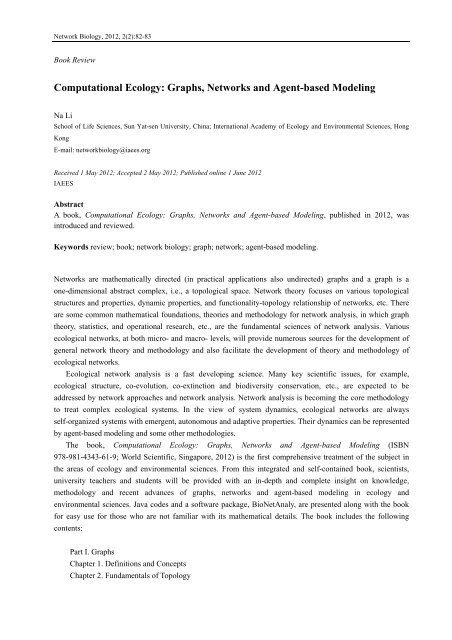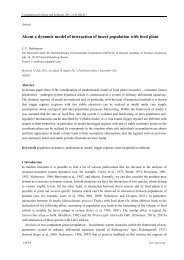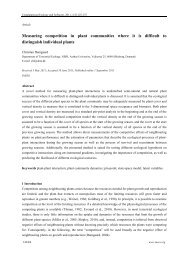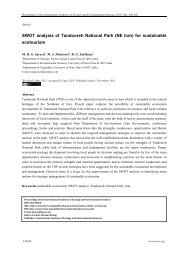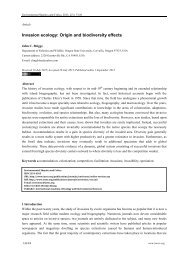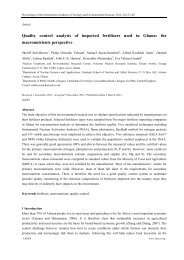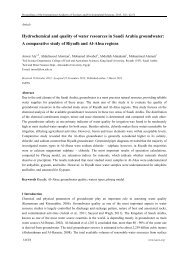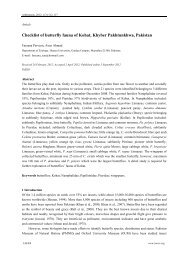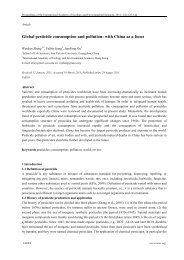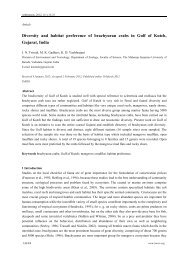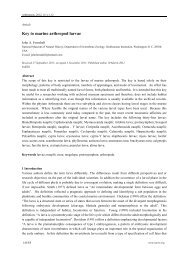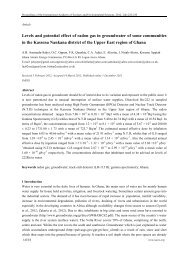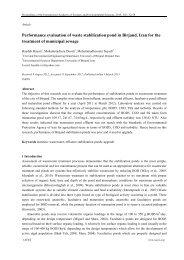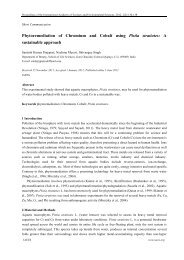Computational Ecology: Graphs, Networks and Agent-based Modeling
Computational Ecology: Graphs, Networks and Agent-based Modeling
Computational Ecology: Graphs, Networks and Agent-based Modeling
Create successful ePaper yourself
Turn your PDF publications into a flip-book with our unique Google optimized e-Paper software.
Network Biology, 2012, 2(2):82-83<br />
Book Review<br />
<strong>Computational</strong> <strong>Ecology</strong>: <strong>Graphs</strong>, <strong>Networks</strong> <strong>and</strong> <strong>Agent</strong>-<strong>based</strong> <strong>Modeling</strong><br />
Na Li<br />
School of Life Sciences, Sun Yat-sen University, China; International Academy of <strong>Ecology</strong> <strong>and</strong> Environmental Sciences, Hong<br />
Kong<br />
E-mail: networkbiology@iaees.org<br />
Received 1 May 2012; Accepted 2 May 2012; Published online 1 June 2012<br />
IAEES<br />
Abstract<br />
A book, <strong>Computational</strong> <strong>Ecology</strong>: <strong>Graphs</strong>, <strong>Networks</strong> <strong>and</strong> <strong>Agent</strong>-<strong>based</strong> <strong>Modeling</strong>, published in 2012, was<br />
introduced <strong>and</strong> reviewed.<br />
Keywords review; book; network biology; graph; network; agent-<strong>based</strong> modeling.<br />
<strong>Networks</strong> are mathematically directed (in practical applications also undirected) graphs <strong>and</strong> a graph is a<br />
one-dimensional abstract complex, i.e., a topological space. Network theory focuses on various topological<br />
structures <strong>and</strong> properties, dynamic properties, <strong>and</strong> functionality-topology relationship of networks, etc. There<br />
are some common mathematical foundations, theories <strong>and</strong> methodology for network analysis, in which graph<br />
theory, statistics, <strong>and</strong> operational research, etc., are the fundamental sciences of network analysis. Various<br />
ecological networks, at both micro- <strong>and</strong> macro- levels, will provide numerous sources for the development of<br />
general network theory <strong>and</strong> methodology <strong>and</strong> also facilitate the development of theory <strong>and</strong> methodology of<br />
ecological networks.<br />
Ecological network analysis is a fast developing science. Many key scientific issues, for example,<br />
ecological structure, co-evolution, co-extinction <strong>and</strong> biodiversity conservation, etc., are expected to be<br />
addressed by network approaches <strong>and</strong> network analysis. Network analysis is becoming the core methodology<br />
to treat complex ecological systems. In the view of system dynamics, ecological networks are always<br />
self-organized systems with emergent, autonomous <strong>and</strong> adaptive properties. Their dynamics can be represented<br />
by agent-<strong>based</strong> modeling <strong>and</strong> some other methodologies.<br />
The book, <strong>Computational</strong> <strong>Ecology</strong>: <strong>Graphs</strong>, <strong>Networks</strong> <strong>and</strong> <strong>Agent</strong>-<strong>based</strong> <strong>Modeling</strong> (ISBN<br />
978-981-4343-61-9; World Scientific, Singapore, 2012) is the first comprehensive treatment of the subject in<br />
the areas of ecology <strong>and</strong> environmental sciences. From this integrated <strong>and</strong> self-contained book, scientists,<br />
university teachers <strong>and</strong> students will be provided with an in-depth <strong>and</strong> complete insight on knowledge,<br />
methodology <strong>and</strong> recent advances of graphs, networks <strong>and</strong> agent-<strong>based</strong> modeling in ecology <strong>and</strong><br />
environmental sciences. Java codes <strong>and</strong> a software package, BioNetAnaly, are presented along with the book<br />
for easy use for those who are not familiar with its mathematical details. The book includes the following<br />
contents:<br />
Part I. <strong>Graphs</strong><br />
Chapter 1. Definitions <strong>and</strong> Concepts<br />
Chapter 2. Fundamentals of Topology
Network Biology, 2012, 2(2):82-83<br />
83<br />
Chapter 3. Matrix Representations <strong>and</strong> Computer Storage of <strong>Graphs</strong><br />
Chapter 4. Trees <strong>and</strong> Planar <strong>Graphs</strong><br />
Chapter 5. Algorithms of <strong>Graphs</strong><br />
Chapter 6. Directed <strong>Graphs</strong><br />
Part II. <strong>Networks</strong><br />
Chapter 7. <strong>Networks</strong><br />
Chapter 8. Complex <strong>Networks</strong> <strong>and</strong> Network Analysis<br />
Chapter 9. Ecological Network Analysis: Research Advances<br />
Chapter 10. Ecological Network Analysis: Innovations<br />
Part III. <strong>Agent</strong>-<strong>based</strong> <strong>Modeling</strong><br />
Chapter 11. <strong>Agent</strong>-<strong>based</strong> <strong>Modeling</strong><br />
Chapter 12. Cell Automata <strong>Modeling</strong> of Pest Percolation<br />
Chapter 13. ABM Frame for Biological Community Succession <strong>and</strong> Assembly<br />
Chapter 14. <strong>Agent</strong>-<strong>based</strong> <strong>Modeling</strong> of Ecological Problems<br />
Users can download the software, BioNetAnaly, at: http://www.iaees.org/publications/software/index.asp.<br />
Reference<br />
Zhang WJ. <strong>Computational</strong> <strong>Ecology</strong>: <strong>Graphs</strong>, <strong>Networks</strong> <strong>and</strong> <strong>Agent</strong>-<strong>based</strong> <strong>Modeling</strong>. World Scientific,<br />
Singapore, 2012<br />
IAEES<br />
www.iaees.org


